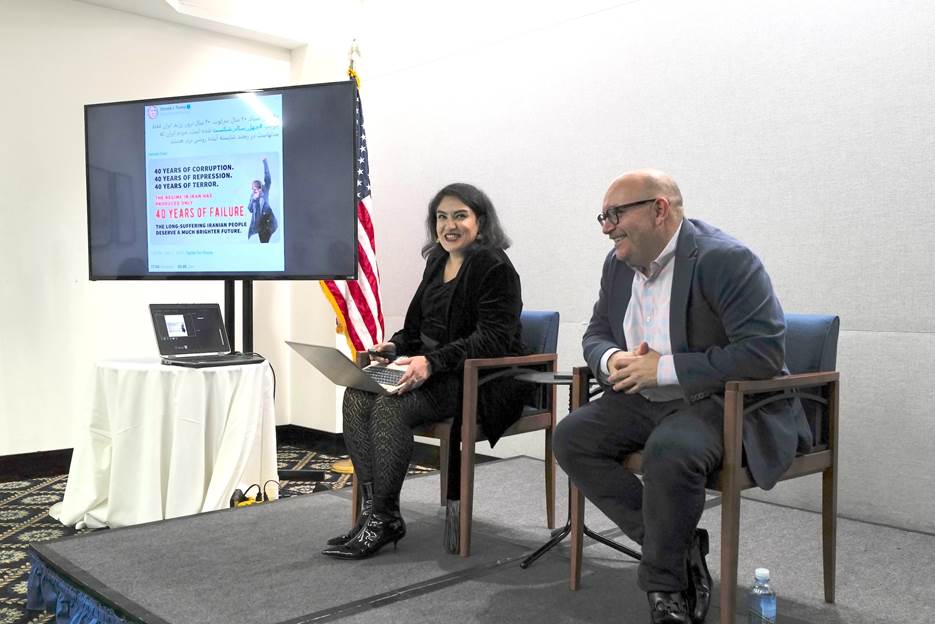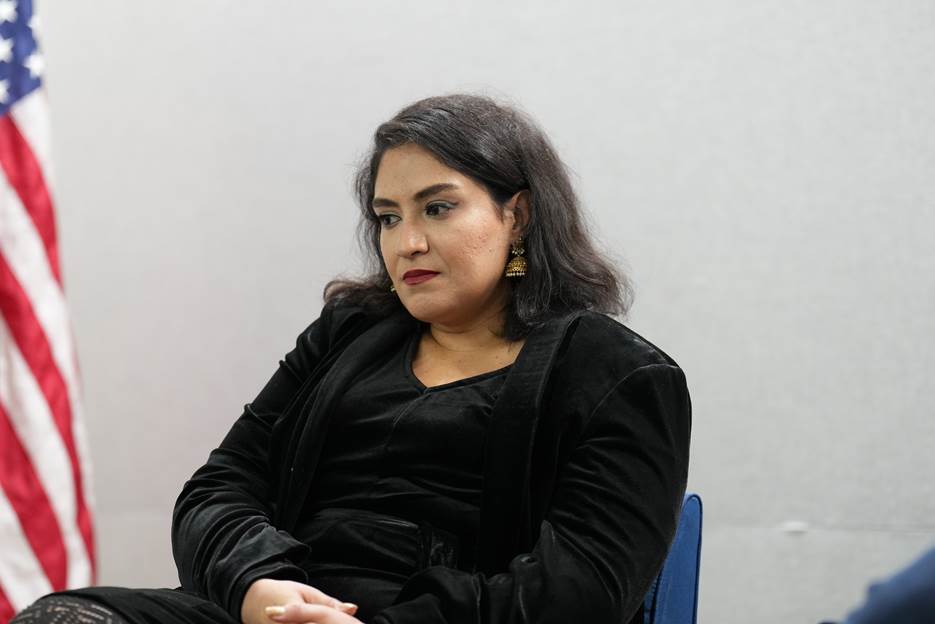
Moderating Yalda Moaiery’s presentation, “A Journey Through a Lens,” was Washington Post journalist Jason Rezaian, the Post’s former bureau chief in Tehran who was convicted of espionage in 2015 after a closed-door trail and imprisoned for 544 days until his release in 2016
Photojournalist Yalda Moaiery’s Journey through a Lens
Report and photos by Phil Pasquini

Washington: Visiting Iranian photojournalist Yalda Moaiery spoke on November 10 in an informal setting at the National Press Club discussing her work and the state of press freedom in Iran. Moderating her presentation, “A Journey Through a Lens,” was Washington Post journalist Jason Rezaian, the Post’s former bureau chief in Tehran who was convicted of espionage in 2015 after a closed-door trail and imprisoned for 544 days until his release in 2016.
Moaiery began by crediting her father, a photographer, who introduced her to photography when she first began taking photos at an early age. By the age of fifteen she had her first photos published setting the course of her life’s work. Her work as a photojournalist has seen her covering conflict zones and wars across the Middle East including coverage of natural disasters, so dedicated in her work that she and her journalist husband used their wedding gift money to travel to Indonesia in 2004 to cover the massive earthquake and tsunami that devastated the west coast of northern Sumatra.
During her 23-year career, her photographs have been published worldwide in major newspapers and magazines with her most famous image being the unauthorized use of one by Donald Trump in a 2019 tweet in Farsi commenting on the 40th anniversary of the Iranian Revolution in his attack on the government of Iran. His use of her photograph prompted her response in saying , “It would be a great honor for me if this image would be a symbol of freedom everywhere in the world.” But for President Trump to “use it without my permission in a tweet in Persian even is a great shame for me and causes me deep sorrow.” The entire matter elevated her career, bringing her greater recognition and presence in her profession.

While covering a public hijab protest in Tehran in 2022 in the aftermath of the Mahsa Amini killing, she was arrested and injured by the morality police and imprisoned in Iran’s Qarchak women’s prison. In December of last year, the award-winning photojournalist was released on bail and is now awaiting her day in court and potential trial on “anti-state charges” while facing a six-year sentence if convicted.
In 2023 she was one of three journalists who received the International Women's Media Foundation's Wallis Annenberg Justice for Women Journalists Award. Her award was for journalists who have been unjustly jailed or imprisoned. The prestigious award acknowledged in part that the awardees’ work “…as truth tellers amid a sea of disinformation and public, state-sanctioned efforts to silence their voices is a true act of bravery.”
During her talk, Moaiery showed and discussed several of her photographs telling their backstories that illustrated various regions and conflicts along with natural disasters that she has covered. She has been especially motivated in her work by covering and the telling of the lives of women in Iran.
In her presentation, she talked briefly about each image revealing the back story of her experience in taking the powerful photographs and the subjects. She revealed, too, that being Iranian often times afforded her access to people and subjects that other photojournalists would not have had.
One ironic twist in her career was the earlier coverage of women imprisoned in Qarchak prison where she would later be held after her arrest in the hijab protests. While imprisoned there, she befriended several women who had participated in the protests and, after their release, she photographed them at the scene of their arrests. She told of how they had to do so with extreme caution for fear of being rearrested.
Regarding press freedoms in Iran, she noted that historically protests and demonstrations in the past had been peaceful and that demonstrating or protesting in Iran today has become violent, subjecting participants, especially reporters and photojournalists, to arrests, beatings and imprisonment. So many arrests and imprisonments have taken place that nearly all reporters and photojournalists have left the profession with many now working in menial jobs. It should be noted that Iran is number one on the Committee to Protect Journalists (CPJ) index of having the worst press freedoms in the world while also being first in jailing journalists.
Moaiery went on to say that the regime had in the past ten years trained photojournalists to work for government publications and that their work now has become quite professional in shoring up the regime in the media.
She pointed out, too, how younger people are more willing to challenge the ruling regime and how they have utilized social media—the regime’s greatest threat— to their advantage. She further noted that the government has been unable to shut down social media and that many Iranians have discovered work arounds whenever an attempt is made to do so. So, while media freedom in Iran is nonexistent, Iranians remain well informed of both local and world events.
She noted that sadly, as a profession, “Photojournalism is dead” in Iran.
(Phil Pasquini is a freelance journalist and photographer. His reports and photographs appear in the Washington Report on Middle East Affairs and Nuze.ink. He is the author of Domes, Arches and Minarets: A History of Islamic-Inspired Buildings in America.)

